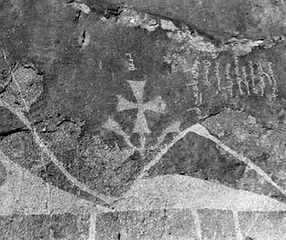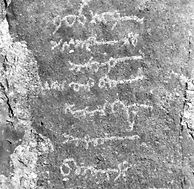ROOHA MEDIA

Tangtse Cross- കാശ്മീരിലെ പുരാതനമായ സ്ലീവകള്






Tangtse is a tiny settlement in the middle of nowhere. Along its main street there are a couple of small guesthouses that provide basic accomodation for foreign visitors on their way to Pangong Lake at the Tibetan border. Tangtse is also the site where rock inscriptions have been preserved. My Ladakhi driver assured me that he knew the exact location. So, we left the village and followed the road to Pangong Lake. Then he stopped the car and pointed at some multicoloured graffiti. It was the well-known Buddhist mantra Om Mani Padme Hum, Praise the Jewel in the Lotus, recently painted in Tibetan script characters on a huge rock above the road. Most probably the work of pious locals or present day believers from abroad, but certainly not the mysterious and age-old inscriptions I was looking for.
Exploring on foot seemed the best way, the slow way of the ancient travellers along the Silk Road. It was the right decision. I reached a small hamlet, just a few mud houses at the edge of the village. It was a magnificent site - enormous boulders lying there close to the stone fences of these shabby houses, in a timeless landscape surrounded by barren mountain peaks. Splendid scenery drenched in solitude. I walked around the boulders and there it was on one of them - the Sogdian rock inscription with the three Nestorian crosses
The Sogdians were an Irano-Aryan people. In ancient times they had settled down in Central Asia, in the area around Samarkand. Alexander the Great invaded their country, he defeated them and married the daughter of a Sogdian leader.
In the period after Alexander the Sogdian territory became part of the kingdom of the Bactrian Greeks. Then Christianity came to these regions. It was the oriental form of Christianity, adopted by the Nestorian Church of the East, which flourished in Persia till the tenth century. Nestorian missionaries followed the Silk Road to Central Asia, they founded Christian communities and preached among the Sogdians.
In those days Sogdian merchants controlled the trade along the Silk Road in Central Asia and converted Sogdians spread Nestorian Christianity in these parts. The Nestorian Church used Syriac, the old Aramaic language, for its liturgy. Sogdian converts translated these sacred texts into their own Irano-Aryan language and so they were preserved, till the storms of history - invasions of nomadic Central-Asian tribes, Buddhist reaction and the rise of Islam - swept away this christianized Sogdian civilization and buried it under the desert sands of Central-Asia. Few relics survived. One of them is the Sogdian rock inscription at Tangtse.
he inscripion on the boulder at Tangtse is still there, though surrounded by more recent graffiti from casual Buddhist travellers. The Sogdian text of the inscription goes as follows: In the year 210 (Arab calendar, corresponding with 825 AD) we sent Caitra from Samarkand together with the monk Nosfarn as messengers to the King of Tibet.Three Nestorian crosses are carved to the left of the Sogdian inscription. If the text and the crosses belong together, which is a tempting and even reasonable presumption, the monk who is called Nosfarn in the inscription may have been a Nestorian messenger. One can imagine him looking for shelter after the long march over the Changla pass, sitting there wrapped in his cloth and carving the sign of his Christian creed in the rock. His hands cold as ice, his religious zeal unbroken.